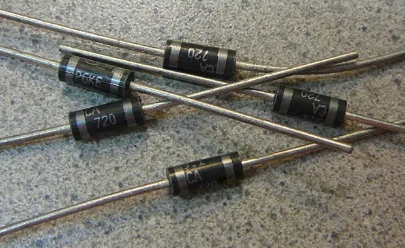What are TVS diodes in safeguarding electronics
In today’s interconnected world, electronic devices and systems are ubiquitous, powering our homes, workplaces, and communication networks. However, these devices are vulnerable to voltage transients—brief surges in voltage that can occur due to lightning strikes, electrostatic discharge (ESD), or switching transients in the electrical system.

To protect sensitive electronic components from such transients, Transient Voltage Suppressor TVS diodes play a crucial role. This article explores the functionality, applications, and importance of TVS diodes in safeguarding electronics.
What is a Transient Voltage Suppressor (TVS) Diode?A Transient Voltage Suppressor (TVS) diode is a semiconductor device used to protect sensitive electronic components from voltage spikes or transient voltages that could potentially damage them. These spikes can be caused by events such as lightning strikes, electrostatic discharge (ESD), or switching transients in the electrical system.
The TVS diode operates by providing a low-impedance path to divert excess voltage away from the protected components, thus limiting the voltage across them. When a transient voltage exceeds the breakdown voltage (also known as the clamping voltage or avalanche voltage) of the TVS diode, it starts to conduct, effectively shunting the excess current away from the protected circuit.
What are the features of TVS diodes?Fast Response Time: TVS diodes respond quickly to transient events, providing protection within nanoseconds to microseconds.
Low Clamping Voltage: The clamping voltage is the maximum voltage that the TVS diode allows to pass through to the protected circuit. It is typically lower than the voltage tolerance of the protected components, ensuring they remain safe.
High Surge Current Capability: TVS diodes are designed to handle high surge currents associated with transient events, protecting the circuit from damage.
Low Leakage Current: When not conducting, TVS diodes have low leakage current, minimizing power consumption and ensuring minimal impact on the protected circuit during normal operation.
Robustness: TVS diodes are robust devices, able to withstand multiple transient events without degradation in performance.
What are the applications of TVS diode?TVS diodes are commonly used in various applications, including:
Protection of integrated circuits (ICs), microcontrollers, and other semiconductor devices from ESD and voltage transients.
Protection of communication ports (such as USB, Ethernet, HDMI) and data lines in electronic equipment.
Surge protection for power supply lines, signal lines, and sensor inputs in industrial and automotive electronics.
Protection of sensitive electronic equipment against lightning-induced surges in telecommunications, power distribution, and other infrastructure.
What’s the difference between TVS Diodes and Zener Diodes?TVS (Transient Voltage Suppressor) diodes and Zener diodes are both semiconductor devices used for voltage regulation, but they serve different purposes and operate in different ways. Here are the key differences between TVS diodes and Zener diodes:
Purpose:
• TVS Diodes: TVS diodes are primarily used for transient voltage suppression, meaning they protect electronic circuits from voltage spikes or transients caused by events like lightning strikes, electrostatic discharge (ESD), or inductive switching. Their main function is to provide surge protection and prevent damage to sensitive components.
• Zener Diodes: Zener diodes are used for voltage regulation and voltage reference. They operate in the breakdown region and maintain a constant voltage across their terminals when reverse biased. Zener diodes are commonly used in voltage regulation circuits, voltage clamping circuits, and voltage reference circuits.
Operating Principle:
• TVS Diodes: TVS diodes operate by avalanche breakdown or Zener breakdown. When the voltage across a TVS diode exceeds its breakdown voltage, it starts to conduct heavily, providing a low-impedance path for excess current and diverting it away from the protected circuit.
• Zener Diodes: Zener diodes operate in the reverse-biased breakdown region, where they maintain a constant voltage (known as the Zener voltage) across their terminals. They regulate voltage by allowing current to flow in the reverse direction when the applied voltage exceeds the Zener voltage.
Voltage Characteristics:
• TVS Diodes: TVS diodes typically have a very low clamping voltage (Vc) and are designed to handle high surge currents associated with transient events. They are optimized for fast response times and high-energy absorption capabilities.
• Zener Diodes: Zener diodes have a well-defined breakdown voltage (Vz) at which they operate. The voltage across a Zener diode remains relatively constant over a wide range of currents when reverse biased, making them suitable for voltage regulation applications.
Applications:
• TVS Diodes: TVS diodes are used in applications requiring protection against voltage transients, such as in power supplies, communication ports (USB, Ethernet), data lines, and electronic equipment exposed to harsh environments or prone to ESD.
• Zener Diodes: Zener diodes find applications in voltage regulation circuits, voltage references, voltage clamping circuits, reverse voltage protection, and precision voltage measurement circuits.
How do TVS diodes work?
TVS diodes work by providing a low-impedance path for excess voltage, diverting it away from sensitive electronic components and limiting the voltage across them to safe levels. They operate based on two main mechanisms: avalanche breakdown and Zener breakdown. Here’s how TVS diodes work:
Avalanche BreakdownTVS diodes are typically fabricated with a highly doped semiconductor material that has a narrow depletion region. When the diode is reverse-biased (i.e., the voltage applied across it is in the opposite direction of its normal operation), the electric field across the depletion region increases.
If the applied reverse voltage exceeds a certain threshold known as the breakdown voltage (also called clamping voltage or avalanche voltage), the strong electric field can accelerate charge carriers (electrons and holes) to high energies.
These high-energy charge carriers collide with other atoms in the semiconductor lattice, generating additional charge carriers through impact ionization. This process cascades, resulting in a sudden increase in current flow through the diode.
As a result, the TVS diode effectively clamps the voltage across its terminals at the breakdown voltage, providing a low-impedance path for excess current and limiting the voltage seen by the protected circuit.
Zener BreakdownIn addition to avalanche breakdown, some TVS diodes may also utilize Zener breakdown to provide transient voltage suppression. Zener breakdown occurs when the reverse-biased diode operates in its Zener breakdown region.
In this region, the diode behaves as a voltage regulator, maintaining a relatively constant voltage (known as the Zener voltage) across its terminals. When the applied reverse voltage exceeds the Zener voltage, the diode starts conducting heavily, effectively clamping the voltage across it.
What causes a TVS diode to fail?TVS diodes are designed to withstand high levels of transient voltage and provide protection to sensitive electronic components. However, like any electronic component, TVS diodes can fail under certain conditions. Here are some common causes of TVS diode failure:
Overvoltage Conditions: If the transient voltage exceeds the maximum rated clamping voltage (avalanche or Zener breakdown voltage) of the TVS diode, it may fail to suppress the transient effectively. This can happen if the transient event is exceptionally severe or if the TVS diode is underspecified for the application.
Overcurrent Conditions: Excessive current flowing through the TVS diode, either due to a high-energy transient event or a sustained fault condition, can cause the diode to fail. Overcurrent can lead to thermal overstress, causing the diode to overheat and potentially short or open circuit.
Reverse Polarity: Applying a reverse voltage beyond the maximum reverse voltage rating of the TVS diode can cause it to fail. This can occur due to improper installation or incorrect wiring in the circuit.
End-of-Life Wear-Out: Like all semiconductor devices, TVS diodes have a limited lifespan, and their performance may degrade over time due to factors such as aging, temperature cycling, and electrical stress. As the diode approaches the end of its life, its ability to suppress transients effectively may diminish, leading to failure.
Excessive Power Dissipation: TVS diodes are specified with maximum power dissipation ratings. Exceeding these ratings, either due to sustained overvoltage conditions or prolonged exposure to transient events, can cause the diode to overheat and fail.
Manufacturing Defects: Rarely, TVS diodes may fail due to manufacturing defects such as material impurities, processing errors, or incomplete encapsulation. These defects can compromise the electrical and thermal performance of the diode, leading to premature failure.
Improper Handling or Installation: Mishandling or improper installation of TVS diodes, such as mechanical stress during assembly, soldering defects, or exposure to corrosive environments, can lead to physical damage or degradation of the diode, resulting in failure.
ConclusionTVS diodes are essential components in protecting electronic devices and systems from voltage transients. Their ability to clamp voltages and divert excess current away from sensitive components plays a vital role in ensuring the reliability and durability of modern electronics. As the demand for high-performance and reliable electronic products continues to grow, the importance of TVS diodes in safeguarding electronics will only increase, making them indispensable in today’s interconnected world.
在线留言询价
- 一周热料
- 紧缺物料秒杀
| 型号 | 品牌 | 询价 |
|---|---|---|
| BD71847AMWV-E2 | ROHM Semiconductor | |
| CDZVT2R20B | ROHM Semiconductor | |
| TL431ACLPR | Texas Instruments | |
| RB751G-40T2R | ROHM Semiconductor | |
| MC33074DR2G | onsemi |
| 型号 | 品牌 | 抢购 |
|---|---|---|
| IPZ40N04S5L4R8ATMA1 | Infineon Technologies | |
| BU33JA2MNVX-CTL | ROHM Semiconductor | |
| TPS63050YFFR | Texas Instruments | |
| ESR03EZPJ151 | ROHM Semiconductor | |
| BP3621 | ROHM Semiconductor | |
| STM32F429IGT6 | STMicroelectronics |
- 周排行榜
- 月排行榜
AMEYA360公众号二维码
识别二维码,即可关注


请输入下方图片中的验证码:






















